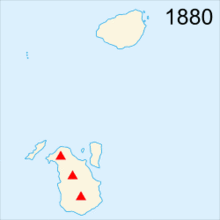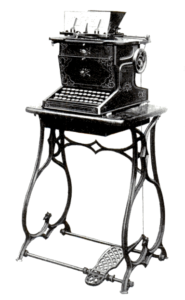Good morning, Whitewater.
Saturday in town will bring thunderstorms and a high of eighty-one. Sunrise is 6:15 AM and sunset 7:36 PM, for 13h 20m 34s of daytime. The moon is a waning crescent with 24.9% of its visible disk illuminated.
On this day in 1883, volcanic eruptions destroy Krakatoa and cause global effects:
The 1883 eruption of Krakatoa in the Dutch East Indies (now Indonesia) began in the afternoon of August 26, 1883 (with origins as early as May of that year), and culminated with several destructive eruptions of the remaining caldera. On August 27, two-thirds of Krakatoa collapsed in a chain of titanic explosions, destroying most of the island and its surrounding archipelago. Additional alleged seismic activity continued to be reported until February 1884, though reports of those after October 1883 were later dismissed by Rogier Verbeek‘s investigation. It was one of the deadliest and most destructive volcanic events in recorded history, with at least 36,000 deaths being attributed to the eruption itself and the tsunamis it created. Significant additional effects were also felt around the world….
The eruption darkened the sky worldwide for years afterwards, and produced spectacular sunsets throughout the world for many months. British artist William Ashcroft made thousands of colour sketches of the red sunsets halfway around the world from Krakatoa in the years after the eruption. The ash caused “such vivid red sunsets that fire engines were called out in New York, Poughkeepsie, and New Haven to quench the apparent conflagration.”[16] This eruption also produced a Bishop’s Ring around the sun by day, and a volcanic purple light at twilight.
In 2004, an astronomer proposed the idea that the blood-red sky shown in Edvard Munch‘s famous 1893 painting The Scream is also an accurate depiction of the sky over Norway after the eruption.[17]
Weather watchers of the time tracked and mapped the effects on the sky. They labeled the phenomenon the “equatorial smoke stream”.[18] This was the first identification of what is known today as the jet stream.[19]
For several years following the eruption, it was reported that the moon appeared to be blue and sometimes green. This was because some of the ash clouds were filled with particles about 1 µm wide—the right size to strongly scatter red light, while allowing other colors to pass. White moonbeams shining through the clouds emerged blue, and sometimes green. People also saw lavender suns and, for the first time, recorded noctilucent clouds.[16]
On this day in 1878, Sholes patents the typewriter:
On this date Christopher Latham Sholes patented the typewriter. The idea for this invention began at Kleinsteuber’s Machine Shop in Milwaukee in the late 1860s. A mechanical engineer by training, Sholes, along with associates Carlos Glidden and Samuel Soulé, spent hours tinkering with the idea. They mounted the key of an old telegraph instrument on a base and tapped down on it to hit carbon & paper against a glass plate.
This idea was simple, but in 1868 the mere idea that type striking against paper might produce an image was a novelty. Sholes proceeded to construct a machine to reproduce the entire alphabet. The prototype was sent to Washington as the required Patent Model. This original model still exists at the Smithsonian. Investor James Densmore provided the marketing impetus which eventually brought the machine to the Remington Arms Company. Although Remington mass-marketed his typewriter beginning in 1874, it was not an instant success.
A few years later, improvements made by Remington engineers gave the machine its market appeal and sales skyrocketed. [Source: Wisconsin Lore and Legends, p.41]


